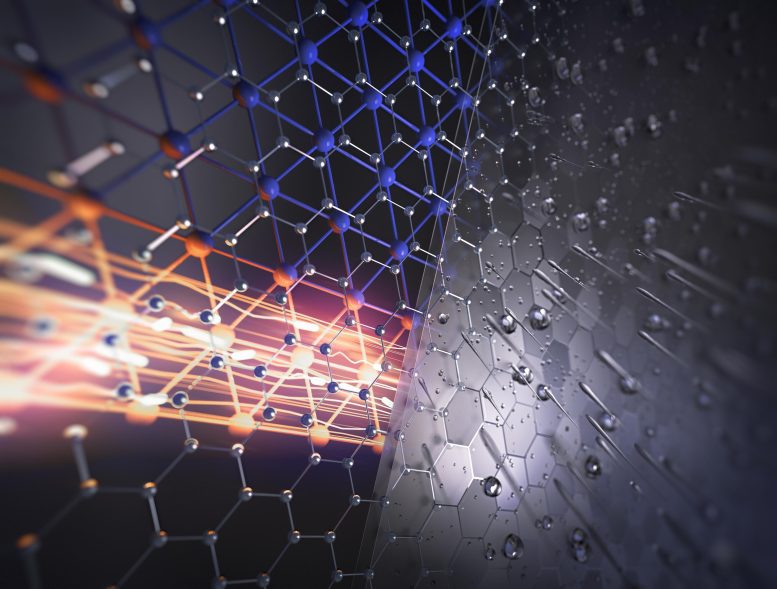
Schematic representation showing how a graphene layer protects against water. The electrical current flowing along the edge of the topological insulator indenene remains completely unaffected by external influences. Credit: Jörg Bandmann, pixelwg
Researchers have developed a groundbreaking protective coating for indenene, a quantum material promising for ultrafast electronics, enabling its use in air without oxidation. This innovation could revolutionize the future of atomic layer electronics.
The race to create increasingly faster and more powerful computer chips continues as transistors, their fundamental components, shrink to ever smaller and more compact sizes. In a few years, these transistors will measure just a few atoms across – by which point, the miniaturization of the silicon technology currently used will have reached its physical limits. Consequently, the quest for alternative materials with entirely new properties is crucial for future technological advancements.
Back in 2021, scientists from the Cluster of Excellence ct.qmat – Complexity and Topology in Quantum Matter at the universities JMU Würzburg and TU Dresden made a significant discovery: topological quantum materials such as indenene, which hold great promise for ultrafast, energy-efficient electronics. The resulting, extremely thin quantum semiconductors are composed of a single atom layer – in indenene’s case, indium atoms – and act as topological insulators, conducting electricity virtually without resistance along their edges.
“Producing such a single atomic layer requires sophisticated vacuum equipment and a specific substrate material. To utilize this two-dimensional material in electronic components, it would need to be removed from the vacuum environment. However, exposure to air, even briefly, leads to oxidation, destroying its revolutionary properties and rendering it useless,” explains experimental physicist Professor Ralph Claessen, ct.qmat’s Würzburg spokesperson.
The ct.qmat Würzburg team has now managed to solve this problem. Their results have been published in the journal Nature Communications.
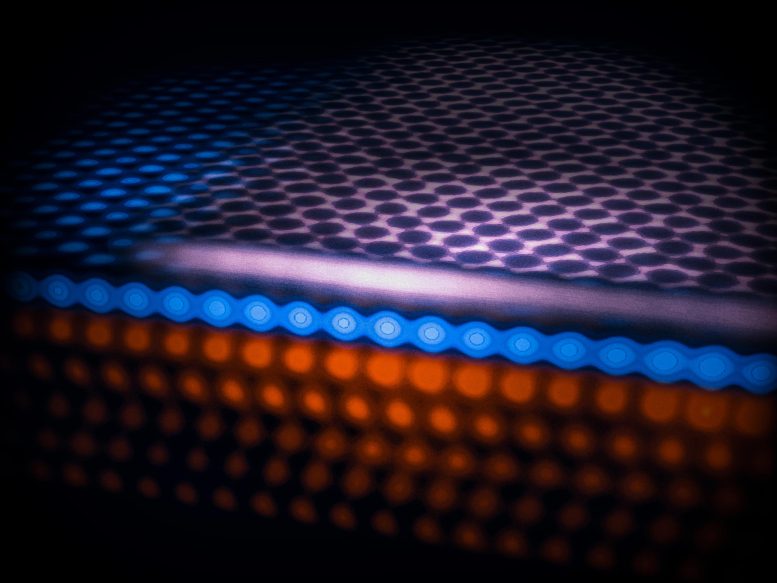
Amalgamation of experimental images. At the top, a scanning tunneling microscopy image displays the graphene’s honeycomb lattice (the protective layer). In the center, electron microscopy shows a top view of the material indenene as a triangular lattice. Below it is a side view of the silicon carbide substrate. It can be seen that both the indenene and the graphene consist of a single atomic layer. Credit: Jonas Erhardt/Christoph Mäder)
In Search of a Protective Coating
“We dedicated two years to finding a method to protect the sensitive indenene layer from environmental elements using a protective coating. The challenge was ensuring that this coating did not interact with the indenene layer,” explains Cedric Schmitt, one of Claessen’s doctoral students involved in the project. This interaction is problematic because when different types of atoms – from the protective layer and the semiconductor, for instance – meet, they react chemically at the atomic level, changing the material. This isn’t a problem with conventional silicon chips, which comprise multiple atomic layers, leaving sufficient layers unaffected and hence still functional.
“A semiconductor material consisting of a single atomic layer such as indenene would normally be compromised by a protective film. This posed a seemingly insurmountable challenge that piqued our research curiosity,” says Claessen. The search for a viable protective layer led them to explore van der Waals materials, named after the Dutch physicist Johannes Diderik van der Waals (1837–1923). Claessen explains: “These two-dimensional van der Waals atomic layers are characterized by strong internal bonds between their atoms, while only weakly bonding to the substrate. This concept is akin to how pencil lead made of graphite – a form of carbon with atoms arranged in honeycomb layers – writes on paper. The layers of graphene can be easily separated. We aimed to replicate this characteristic.”
Success!
Using sophisticated ultrahigh vacuum equipment, the Würzburg team experimented with heating silicon carbide (SiC) as a substrate for indenene, exploring the conditions needed to form graphene from it. “Silicon carbide consists of silicon and carbon atoms. Heating it causes the carbon atoms to detach from the surface and form graphene,” says Schmitt, elucidating the laboratory process. “We then vapor-deposited indium atoms, which are immersed between the protective graphene layer and the silicon carbide substrate. This is how the protective layer for our two-dimensional quantum material indenene was formed.”
Umbrella Unfurled
For the first time globally, Claessen and his team at ct.qmat’s Würzburg branch successfully crafted a functional protective layer for a two-dimensional quantum semiconductor material without compromising its extraordinary quantum properties. After analyzing the fabrication process, they thoroughly tested the layer’s protective capabilities against oxidation and corrosion. “It works! The sample can even be exposed to water without being affected in any way,” says Claessen with delight. “The graphene layer acts like an umbrella for our indenene.”
Toward Atomic Layer Electronics
This breakthrough paves the way for applications involving highly sensitive semiconductor atomic layers. The manufacture of ultrathin electronic components requires them to be processed in air or other chemical environments. This has been made possible thanks to the discovery of this protective mechanism. The team in Würzburg is now focused on identifying more van der Waals materials that can serve as protective layers – and they already have a few prospects in mind. The snag is that despite graphene’s effective protection of atomic monolayers against environmental factors, its electrical conductivity poses a risk of short circuits. The Würzburg scientists are working on overcoming these challenges and creating the conditions for tomorrow’s atomic layer electronics.
Cluster of Excellence ct.qmat
The Cluster of Excellence ct.qmat – Complexity and Topology in Quantum Matter has been jointly run by Julius-Maximilians-Universität (JMU) Würzburg and Technische Universität (TU) Dresden since 2019. Over 300 scientists from more than thirty countries and four continents study topological quantum materials that reveal surprising phenomena under extreme conditions such as ultra-low temperatures, high pressure, or strong magnetic fields. ct.qmat is funded through the German Excellence Strategy of the Federal and State Governments and is the only Cluster of Excellence in Germany to be based in two different federal states.
Reference: “Achieving environmental stability in an atomically thin quantum spin Hall insulator via graphene intercalation” by Cedric Schmitt, Jonas Erhardt, Philipp Eck, Matthias Schmitt, Kyungchan Lee, Philipp Keßler, Tim Wagner, Merit Spring, Bing Liu, Stefan Enzner, Martin Kamp, Vedran Jovic, Chris Jozwiak, Aaron Bostwick, Eli Rotenberg, Timur Kim, Cephise Cacho, Tien-Lin Lee, Giorgio Sangiovanni, Simon Moser and Ralph Claessen, 19 February 2024, Nature Communications.
DOI: 10.1038/s41467-024-45816-9



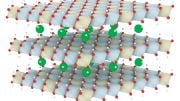

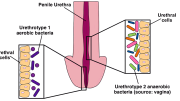
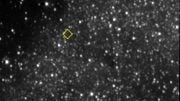

The advent of graphene is becoming one of the key components of quantum mechanics and with all the evidence of collaboration of sciences and academics can only bring forward a more refined and collective agreement in terms and beliefs lowing the exclusion denial platforms of peer review, question, can this graphene armor be be used in the advent of quantum computing to shield the noise that haunts the qubit error in the system.
Please answer:
1. What is the physical essence of topological quantum materials?
2. Do topological quantum materials have gravitation?
3. Why do topological vortices spin?
4. Is gravitation related to topological vortices?
5. Do you understand the physical reality of quantum mechanics?
6. Are quantum and graphene high-dimensional spacetime matter or low-dimensional spacetime matter?
7. Are topological vortices high-dimensional spacetime matter or low-dimensional spacetime matter?
8. Do topological vortices spin because they have mass?
9. Why does the sun spin?
10. Are so-called academic journals (such as Physical Review Letters, Nature, Science, etc.) scientific and honest?
and so on.
Today, we have already entered the era of the internet. With the help of artificial intelligence and big data, discussions on scientific knowledge have become open and transparent. However, a group of editors of so-called academic journals (such as Physical Review Letters, Nature, Science, etc.) are mystifying themselves. They only care about their own so-called sufficiently high priority rating, general significance, discipline, novelty, etc., and do not care about what science and pseudoscience are.
Science and pseudoscience are not determined by a publication, an organization or a person, nor by you or me, but by mathematics the final say. Physical models must be based on mathematics or mathematical models in order to be scientific, convincing, and in accordance with natural laws.
The branch of mathematics known as topology has become a cornerstone of modern physics. The perpetually swirling topological vortices defy traditional physics’ expectations. A physical properties of topological vortices is their to spontaneously begin to change periodically in time, even though the system does not experience corresponding periodic interference. Therefore, in the interaction of topological vortices, time is both absolute and relative,and physics often requires treating space and time at the same level.
Low-dimensional spacetime matter is the foundation of high-dimensional spacetime matter. Low-dimensional spacetime matter (such as topological vortex) can form new material structures and derive more complex physical properties via interactions and self-organization. It is extremely wrong and irresponsible to imagine low dimensional spacetime matter using high-dimensional spacetime matter.
Science must follow mathematical rules. For example, the Standard Model (SM) is considered to be one of the most significant achievements of physics in the 20th century. However, the magnetic moment of μ particle is larger than expected, revealed by a g-2 experiment at Fermilab, suggests that the established theory (such as SM) of fundamental particles is incomplete. Furthermore, the SM omitting gravitation, it not involved the time problem and when the particle movement starts. Mathematics is the foundation of science. Physics must respect the scientific nature of mathematics and mathematical models. The SM must be based on mathematical models in order to be scientific, convincing, and in line with natural laws.
I hope researchers are not fooled by the pseudoscientific theories of the Physical Review Letters (PRL), and hope more people dare to stand up and fight against rampant pseudoscience.
The so-called academic journals (such as Physical Review Letters, Nature, Science, etc.) firmly believe that two high-dimensional spacetime objects (such as two sets of cobalt-60) rotating in opposite directions can be transformed into two objects that mirror each other, is a typical case of pseudoscience rampant.
If researchers are really interested in Science and Physics, you can browse https://zhuanlan.zhihu.com/p/643404671 and https://zhuanlan.zhihu.com/p/595280873.
I’m still asking for accreditations to back the gabb.
Very good! Your accreditations will receive high praise from your peer reviews.
However, science is not your or my the final say, nor your peer reviews the final say, but mathematics.
Please answer:
Why can mathematics become the language of science instead of your peer reviews?